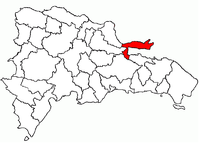Samaná Province
| Samaná | |||
| Province | |||
|
|||
| Country | |||
|---|---|---|---|
| Capital | Samaná | ||
| - elevation | 5 m (16 ft) | ||
| - coordinates | 19°12′0″N 69°19′0″W / 19.20000°N 69.31667°WCoordinates: 19°12′0″N 69°19′0″W / 19.20000°N 69.31667°W | ||
| Area | 853.74 km2 (330 sq mi) | ||
| Population | 139,707 (2014) | ||
| Density | 164/km2 (425/sq mi) | ||
| Province since | 1867 | ||
| Subdivisions | 3 municipalities 3 municipal districts |
||
| Congresspersons | 1 Senator 2 Deputies |
||
| Timezone | AST (UTC−4) | ||
| Area code | 1-809 1-829 1-849 | ||
| ISO 3166-2 | DO-20 | ||
| Postal code | 32000 | ||
|
Location of the Samaná Province
|
|||
Samaná (Spanish pronunciation: [samaˈna]) is a province of the Dominican Republic. Its capital is Santa Bárbara de Samaná, usually known as Samaná.
Samaná is located on the coast of the Atlantic Ocean in the northeastern part of the Dominican Republic. It is known for its mountains of which it is almost entirely formed. Samaná has numerous beaches.On 6 November 2006 the Samaná El Catey International Airport,commenced operations.
Samana was discovered by Europeans on January 12, 1493 by Christopher Columbus who was greeted with a barrage of spears and arrows from native Taíno warriors. It is said that this was the first instance of violent opposition to the Spanish conquistadors in the Americas. The Samaná Province is also home to what are known in the Dominican Republic as Americanos de Samaná (Samaná-Americans) where descendants of free black Americans immigrated beginning in 1824. They took advantage of the pro-African immigration policy of then president Jean Pierre Boyer when Samaná was under Haitian rule. This migration to Santa Bárbara, Samaná began with 34 African-American families. Naturally, this African-American culture distinguished themselves from the rest of the Dominican Republic as they maintain many elements of 19th century African-American culture—such as their brand of English, food, games, community organizations, African-American names, manners, music and some recipes that have been preserved as a result of their isolation, which until the 20th century was accessible only by boat. Most are of the African Methodist Episcopal and Wesleyan faith brought to the island by their ancestors.
Samaná is one of the breeding places of the humpback whale. Thousands of humpback whales come to the coast off Samaná from January to March.
At one time proposed to be the capital of the country, Samaná was to be sold to the United States as a military base during Pedro Santana's presidency, but the deal was never realized, because the United States felt that the cost was too much.
...
Wikipedia



